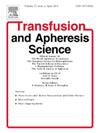Frequency of maternal red blood cell alloantibodies and clinical utility of antibody screening in Abuja, Nigeria
IF 1.2
4区 医学
Q4 HEMATOLOGY
引用次数: 0
Abstract
Background
Pregnancy causes immunisation when the fetal red cells, possessing a paternal antigen foreign to the mother, enter the maternal circulation, resulting in the production of alloantibodies. Maternal allo-immunisation, also known as iso-immunization, occurs when a woman’s immune system is sensitised to foreign erythrocyte surface antigens, stimulating the production of immunoglobulin G (IgG) antibodies. This study was carried out to determine the frequency of maternal Red blood cell alloantibodies in Gwarimpa General Hospital, FCT, Abuja, and to evaluate the clinical utility of antibody screening.
Methods
This was a prospective cross-sectional study involving 250 pregnant women aged 16–45 years recruited from an antenatal care clinic within the period of 6 months. Serum grouping and ABO blood grouping was done using the tube method. Indirect antibody testing was used for antibody screening, using DiaCeLL I + II + III Screening Cells (DiaMed AG, Switzerland), while indirect antiglobulin test was used for antibody identification on all positive cell samples using DiaPanel cells (DiaMed AG, Switzerland).
Result
The result of the study showed that 29.8 % of the study participants have had two pregnancies; only 1.2 % have had greater than 4 pregnancies. The most frequently occurring irregular antibody detected was anti-E; 3 (1.2 %), followed by anti-K; 2 (0.8 %), then anti-C and anti-Jsb (0.4 % respectively). Three of the samples had mixed field reactions, while two could not be identified using the panel cell. A blind anti-globulin cross-match carried out on 250 samples revealed that 5 (2.0 %) were incompatible with blood from the same blood group, while 245 (98.0 %) were compatible with blood from the same blood group.
Conclusion
Efficiency of the screening method was 48.6 % while the percentage safety of the Antibody screening method was 41.6 %. The immune form of anti-E is able to cause a mild to moderate haemolytic disease of the newborn.
尼日利亚阿布贾产妇红细胞同种异体抗体的频率和抗体筛查的临床应用
背景:当胎儿红细胞携带与母体不同的父系抗原进入母体循环,产生同种异体抗体时,妊娠引起免疫。母体同种异体免疫,也称为同种免疫,发生在女性的免疫系统对外来红细胞表面抗原敏感,刺激免疫球蛋白G (IgG)抗体的产生时。本研究旨在确定阿布贾FCT Gwarimpa总医院产妇红细胞同种异体抗体的频率,并评估抗体筛查的临床应用。方法:这是一项前瞻性横断面研究,从一家产前保健诊所招募了250名年龄在16-45岁之间的孕妇,为期6个月。采用试管法进行血清分型和ABO血型分型。抗体筛选采用间接抗体检测,使用DiaCeLL I + II + III筛选细胞(DiaMed AG,瑞士),所有阳性细胞样品采用间接抗球蛋白检测,使用DiaPanel细胞(DiaMed AG,瑞士)。结果研究结果显示,29.8 %的研究参与者有过两次怀孕;只有1.2 %的人怀孕超过4次。检出最多的不规则抗体为抗e抗体;3(1.2 %),其次是anti-K;2(0.8 %),其次是抗c和抗jsb(0.4 %)。三个样品有混合场反应,而两个不能使用面板电池识别。对250份样本进行抗球蛋白盲交叉配型,5份(2.0 %)与同血型血不相容,245份(98.0% %)与同血型血相容。结论该筛选方法的有效率为48.6 %,抗体筛选方法的安全性为41.6 %。抗e抗体的免疫形式能够引起新生儿轻度至中度溶血性疾病。
本文章由计算机程序翻译,如有差异,请以英文原文为准。
求助全文
约1分钟内获得全文
求助全文
来源期刊
CiteScore
3.60
自引率
5.30%
发文量
181
审稿时长
42 days
期刊介绍:
Transfusion and Apheresis Science brings comprehensive and up-to-date information to physicians and health care professionals involved in the rapidly changing fields of transfusion medicine, hemostasis and apheresis. The journal presents original articles relating to scientific and clinical studies in the areas of immunohematology, transfusion practice, bleeding and thrombotic disorders and both therapeutic and donor apheresis including hematopoietic stem cells. Topics covered include the collection and processing of blood, compatibility testing and guidelines for the use of blood products, as well as screening for and transmission of blood-borne diseases. All areas of apheresis - therapeutic and collection - are also addressed. We would like to specifically encourage allied health professionals in this area to submit manuscripts that relate to improved patient and donor care, technical aspects and educational issues.
Transfusion and Apheresis Science features a "Theme" section which includes, in each issue, a group of papers designed to review a specific topic of current importance in transfusion and hemostasis for the discussion of topical issues specific to apheresis and focuses on the operators'' viewpoint. Another section is "What''s Happening" which provides informal reporting of activities in the field. In addition, brief case reports and Letters to the Editor, as well as reviews of meetings and events of general interest, and a listing of recent patents make the journal a complete source of information for practitioners of transfusion, hemostasis and apheresis science. Immediate dissemination of important information is ensured by the commitment of Transfusion and Apheresis Science to rapid publication of both symposia and submitted papers.

 求助内容:
求助内容: 应助结果提醒方式:
应助结果提醒方式:


